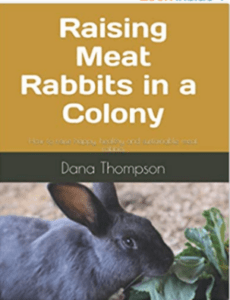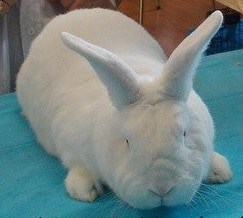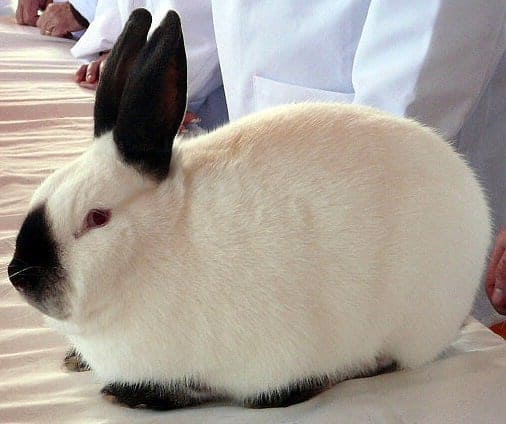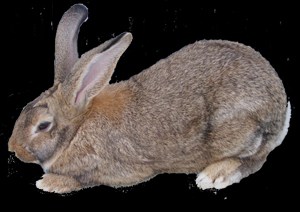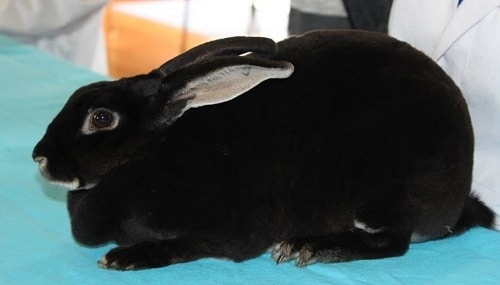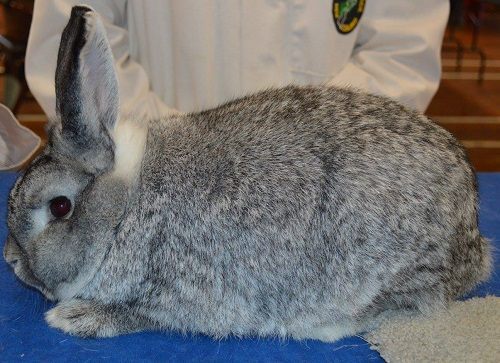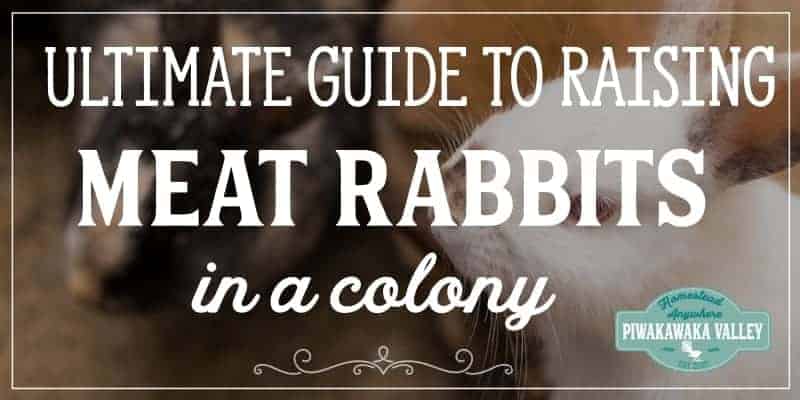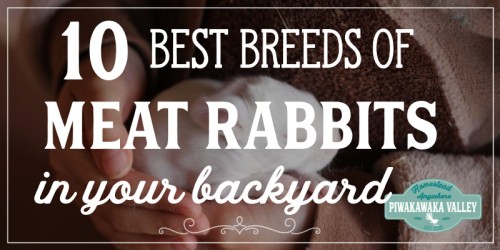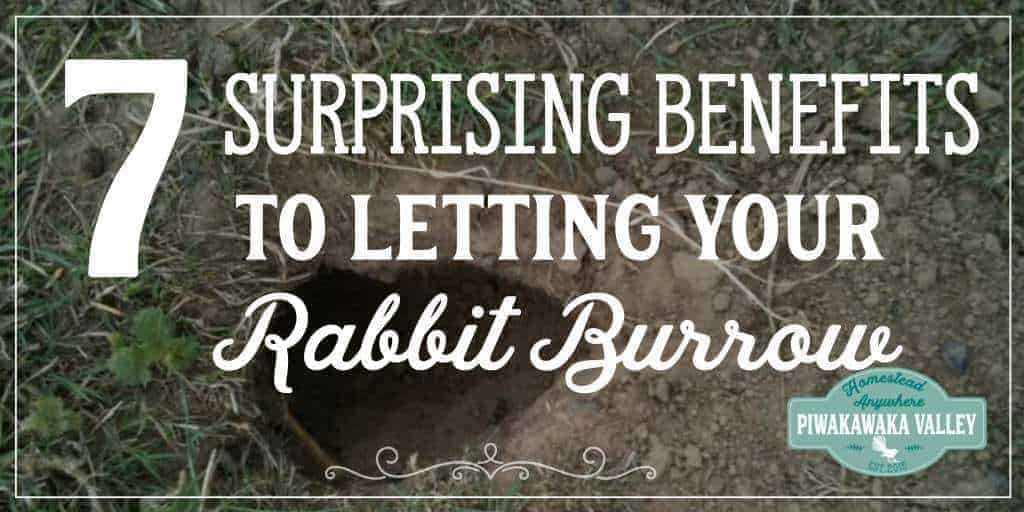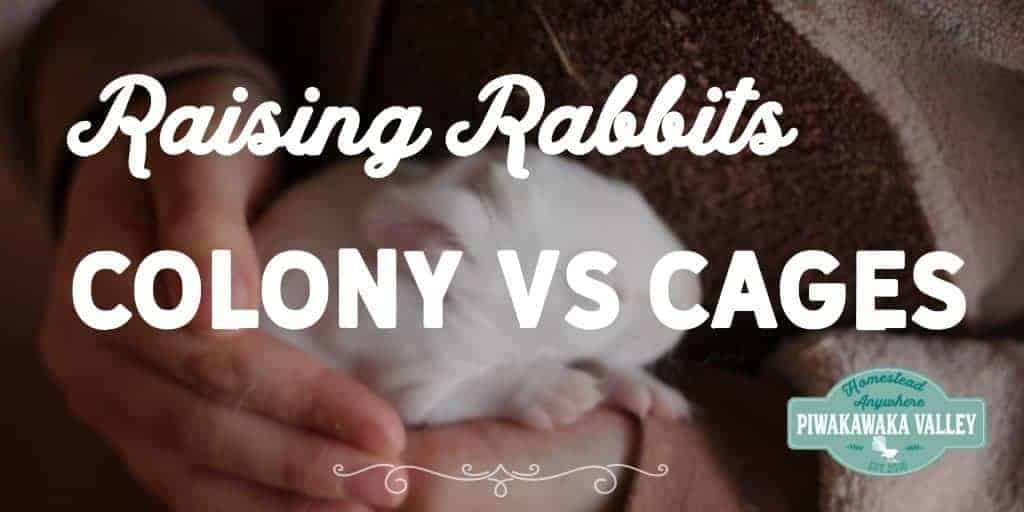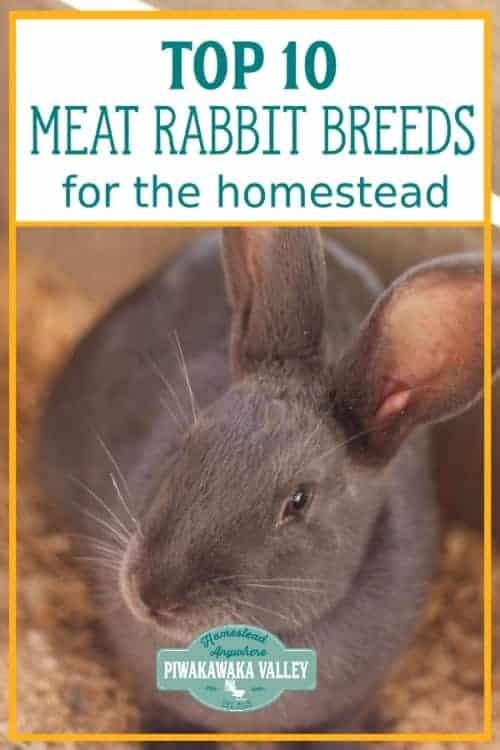This post was most recently updated on July 27th, 2021
You *can* eat any breed of rabbit. But some of them have been bred to convert food to meat faster than others. If you just want efficiency, go for a meat breed. Below are the top 10 best meat rabbit breeds for growth and production.
Please read: This information is provided for educational purposes only and is not intended to treat, diagnose or prevent any disease. We encourage you to make your own health care decisions in partnership with a qualified health care professional.
This post contains affiliate links, this means at no extra cost to you, we make a commission from sales. Please read our Disclosure Statement
When choosing the best meat rabbit for your situation there are a few things you need to consider.
WARNING: This article discusses choosing a rabbit breed to raise for human consumption. If this topic disturbs you, please do not proceed.
Choosing the right breed of meat rabbit for your situation can be very confusing. There are so many meat breeds of rabbits available, and everyone has their own preference.
Things to Consider When Choosing a Meat Rabbit Breed
As we are looking at harvesting between 8-14 weeks old, all the giant breeds have a similar amount of meat on the as the medium sized breeds.
However, they do consume a little more food to get there, so they may not be worth the extra expense in feed to get the same amount of meat at the end.
If you are raising ‘meat mutts’ which are a crossbred mixture, a few giant genes in the mix can be helpful. There are several other things you can do to ensure your rabbits reach their potential size.
Want to know all about raising rabbits in a colony?
Check out our very own book here:
Available on Kindle and in paperback or from our store
Considerations when you are Choosing Meat Rabbits
If you are wanting to use the skins as well you can use rabbits that grow slower. To get good strong usable pelts they rabbits need to be closer to 24-28 weeks old, so you will no longer have ‘fryer’ rabbits, you will have ‘roasters’.
They aren’t as tender and need to be cooked longer. But the pelts of fryer rabbits are very soft and tear easily. So you do need to decide your priorities.
There is, however, no rule saying you have to do one and not the other. You can, of course, do some young ones and keep your fave pelts to grow out the the roaster stage.
Of course, a roaster rabbit will need more room and more food than a fryer rabbit too.
If you are wanting fast meat production to be your main aim then New Zealand Whites or Californians are the best meat rabbit breeds, they are efficient breeders, good mums and fast growers.
If you want to do pelts then the Rex is the gold standard, their pelts are in demand for fashion and craft and they come in wonderful colors.
RELATED: breeding rabbits and raising kits
Top 10 Best Meat Rabbit Breeds
1. NZ WHITE
The NZ white is hands down the fastest grower and most efficient meat rabbit breed to grow.
Despite the name, this breed is American in origin Large in size. These are healthy, hearty, high production rabbits. They put on weight quickly with a good meat to bone ratio. The full grown doe will be about 9-12 lbs while the buck will be 8-10 lbs (4-5.5kg.).
Short coated and mainly bred for pelts and meat. Sentinel rabbit for laboratories.
Does can be aggressive, but we never had any issues with ours.
2. CALIFORNIAN
The Californian was originally created by crossing the New Zealand with a Chinchilla and Himalayan. The Cali has a white body with black points on the ears, nose and feet.
A dual purpose meat and fur rabbit, the Californian is a bit smaller than the New Zealand at 8-10 lbs.
Considered a rare breed in NZ and the breeding pool is getting limited. 3.5-5.5kg
Does are generally gentle and great mothers.
3. FLEMISH GIANT
The largest breed in NZ. Short coated and mainly bred for pets. Can be bred for meat and pelts. An adult will take a lot more food than a smaller rabbit to maintain and the fryers weigh about the same as a smaller breed rabbit at 8-10 weeks.
A great animal to cross into a line to add size and vigor. Comes in a range of colours. Flemish/NZ White cross or Flemish/Californian make great meat babies. 5-6.5kg
Generally friendly and make great pets.
RELATED: Rabbit troubleshooting guide
4. STANDARD REX
Medium in size. Short coated and mainly bred for pelts. Fur is soft and luxurious, a lot like velvet. Kept for fur and the meat is a byproduct.
Medium in size, but in a good line the kits will grow fast. You won’t get the same meat production as a NZ white, but they pelts are AMAZING, and they make great pets on the pet market. 2.8-3.5kg

5. CINNAMON
The Cinnamon has been bred from the Chinchilla, New Zealand, Checkered Giant and Californian and has been an officially recognized breed since the 1970s.
Cinnamon rabbits are rusty colored with dark points. The Cinnamon is another breed that has been used as pet as was as for meat and fur however meat production was the original intent for this breed.
This is a large breed that reaches weights between 8.5 and 11 lbs. They can be very difficult to find.
6. GIANT CHINCHILLA
There are very few of these left in NZ, you will never see them up for sale however they are more available elsewhere in the world.
Large in size. Short coated and mainly bred for pelts and meat. Heavy bone structure, and kits tend to grow bone before meating out, but useful as a cross in a meat-mutt breeding program. 6-6.5kg. Make great pets.
Related: keeping your rabbits healthy
7. STANDARD CHINCHILLA
Medium in size. Short coated and mainly bred for pelts and pets, meat is a bi-product. 2.5-3.5kg
8. SATIN
Medium in size, the satins are often used as meat rabbits because their babies still grow fast. Short coated and mainly bred for pelts or the pet market. Their pelts are super shiny due to hollow hair sheaths, they reflect light and almost seem to glow. 2.8-3.5kg.
9 CHAMPAGNE D ARGENT
The Champagne D Argent is one of the oldest rabbit breeds on record, with its history dating way back to the 17th century.
These beautiful rabbits have been raised for both fur and meat. They have a very good meat to bone ratio.
Generally they are docile and good mothers.
10. FLORIDA WHITE
The Florida White was developed in the 1960’s as an “all” purpose breed.
While they are quite a bit smaller than most traditional meat rabbit lines, they can be brilliant for those raising for meat for only 1 or 2 people or with very limited space.
An adult Florida White will get to 6- 8 lbs with a light bone structure that offers an awesome bone to meat ratio.
They are calm and gentle and are great for beginning rabbit raisers, especially if younger children want to be involved.
Other Options
Meat mutts
There are also what are known as “meat mutts” which are a mixture of breeds, simply a person’s best producing meat stock crossed in together. You can buy from someone’s established meat mutt line and get some very productive rabbits.
Cross breed your own
One upside to mixed breeding is what is known as “hybrid vigor” which is the tendency of a cross-bred individual to show qualities superior to those of both parents. They tend to be hardier and benefit from the good qualities of both parents.
If you are interested in pelts as well, any medium/large sized breed works well. Giant breeds like the English Lop, Giant Chinchilla, and Flemish Giant all grow their bone structure before they fill out, so while they are big animals, they are not efficient meat producers.
What rabbit breed you choose to use is up to you, and may be dependent on personal choice, what is available to you and what your goals are.
To find out what meat breeds are available to you in your area I suggest joining a meat rabbit group on Facebook like Meat Rabbits in Colonies or Commercial Rabbits NZ.
Be warned, pet breeders/owners can get twitchy if you go in asking if you can eat their bunnies!
What Rabbits are Available in NZ
In NZ our choices for meat rabbits are somewhat limited as they simply are not available here. What we call Silver Foxes in NZ are not the same as what you may read about on US pages.
We only have NZ Whites, not NZ Reds or NZ Blues like you read about elsewhere. Some breeds like the Californians and Giant Chinchillas are quite difficult to find.
The weights given are the NZ standard, some of them like the Flemish Giant are quite a lot smaller than US rabbits.
The Difference between Cage and Colony Stock
If you are planning on colony raising your rabbits (highly recommended!) I do suggest you try and find a breeder near you that also colony raises.
You can move caged/older rabbits into a colony, but they seldom thrive the same way colony-native bunnies will.
Our rabbits we got from cages, but they were quite young and adaptable when we got them, so they have taken to it with flying colors.
There are some breeders working towards disease resistance in their colonies, so that is another thing to consider.
Rabbits from proven meat lines, with good chunky square form, are more desirable than one that happens to have a pedigree.
For more information about raising meat rabbits have a look at our Ultimate Guide to Raising Meat Rabbits in Colonies Page
How much does a have?
A from a good genetic line will dress out to about 60-65% . Usually, they are processed at about 5lb or 2.5kg, giving you 3lb or 1.5kg of actual per .
Are New Zealand rabbits good for ? Can you eat wild in New Zealand?
Now, before we get too far in to this, you need to know the difference between a , and a . In New Zealand, we have wild rabbits that are quite different in both function and form to a NZ which is a high efficiency, production that has been bred specifically to provide to commercial farms.
NZ wild tend to be small, tough, stringy and need to be slow cooked for best results. NZ (the ) when butchered at 8-14 weeks is large, tender and tastes almost identical to chicken, especially once it have been brined and then barbequed.
NZ wild rabbits are largely infected by or resistant to Calicivirus (RCD or VHD), this was released to try and reduce the wild population numbers, which largely failed to do so thanks to their natural disease resistance. RCD is species specific and can not affect humans, it also kills very quickly so you are unlikely to find a sick one alive. So, in short, yes, you can eat NZ wild .
What are New Zealand Rabbits?
The wild rabbits in NZ were introduced by early settlers, they are the same species that all domestic rabbits are bred from. The , and subsequent NZ red, blue, and NZ black were actually bred in the USA and has very little to do with the NZ wild rabbits, apart from sharing similar wild heritage.
These are the rabbits commonly known as New Zealand rabbits in the rest of the world are perfect if you are wanting to have a producing . They are commonly crossed with F rabbits to improve size and to introduce hybrid vigor to your kits.
Where are New Zealand rabbits from?
are originally from California, not to be confused with the , which is also from there. There is a suspicion that the original (or at least some of them) may have originated in New Zealand, but it is not known for sure. The was originally red, with the whites becoming popular later on because you can dye the pelts.
What is called?
doesn’t have a special name like beef, venison or pork does. It is commonly referred to as , in the same way that you refer to duck or chicken.
How much do New Zealand rabbits cost?
The price of New Zealand rabbits vary widely, depending on several factors. If you live in an area where NZ rabbits are not common, you will pay more. Expect to pay more for top of the line commercial genetics as well. Prices can range from free (watch out for those, they are likely to have issues) right through to over $100 per . The average price for an average is $30-40.
Why are rabbits pests in New Zealand?
Rabbits were brought with the early settlers to New Zealand as a quickly re-generating source of . Unlike their home country of England, New Zealand has relatively mild winters, and no natural predators for the rabbits. This means that they continued to (like rabbits!) and within a short period of time they took over the farm land.
In previous generations, young boys would leave school and get in to trapping and shooting. This helped to feed the families, and the pelts were sold to make warm coats, gloves and other items. With the trade falling out of favour, and family sizes shrinking, the trapping or shooting employment dried up, resulting in a massive over population of wild rabbits.
Twice there have been releases of the Calicivirus in increasing strengths of strain, to try and control the population. Many desperate farmers had hoped that it would totally destroy the wild population, however the rabbits built immunity to it within a few generations.
Do New Zealand rabbits make good pets?
New Zealand rabbits have been bred to meet high commercial standards. Friendliness is pretty far down the list, well below growth rates, body conformation, and mothering ability. While a well socialized from a smaller that breeds for temperament may make a wonderful , you might be better off with a more common if you are new to rabbits. This is not to say that NZ rabbits cannot make great pets, it is just that overall the tends to be more shy and less inclined to cuddle humans.
How important is your choice of ?
It depends what you are wanting to get out of them. If you are focused solely on , it makes sense to invest in fast growing, commercial lines, probably from New Zealand whites. If you are wanting to save the pelts, or really like to see a mix of colors in your rabbits, then a medium sized will usually grow almost as fast in the first 8-12 weeks. You won’t get quite as much off of them, but the resulting pelts will be more pretty.
Many people successfully mutts, from a variety of different breeds, keeping the ones that meet your required standards. Because of the speed that rabbits reproduce, you can improve your lines very quickly.
What does taste like?
If you have ever had home grown heritage chicken, then you will understand how tastes. It is very very similar to chicken, and can be cooked in much the same way. It is skinless, so it tends to dry out if you are baking it, so be sure to wrap it in bacon or cook it in a sauce.
is slightly firmer than chicken, but it has a similar strength of flavour. Wild caught on the other hand tends to be dark, gamey and tough/stringy. This is more due to the tough life that a wild lives, and the fact that it is likely that you have shot an older rather than a young, tender one. Wild benefits from long stewing with stronger flavours like red wine, tomato and garlic, in much the same way that you would cook old hen or rooster.
How long do New Zealand rabbits live for?
‘s role in nature is as a prey animal, and as such they rapidly and die easily. To ensure your rabbits live a long time, you should ensure that you have your rabbits vaccinated with whatever vaccinations that are recommended where you live and be sure to treat your rabbits for worms and coccidiosis regularly. A healthy will easily live 5-8 years.
At what age do you butcher rabbits?
For best results rabbits are processed at 8-14 weeks, or as soon as they reach 5lb/2.5kg. This will give you the most tender and the most feed to conversion. However, if you are wanting to keep the pelts for anything more than small crafts, you will need to wait until the rabbits are at least 5-6 months old. This size costs significantly more in feed costs, and are much tougher to skin. The needs to be slow cooked with moisture to stop it drying out.
What Breeds do you have at your place?
Want to know all about raising rabbits in a colony?
Check out our very own book here:
Available on Kindle and in paperback or from our store
Please Pin and Share!


